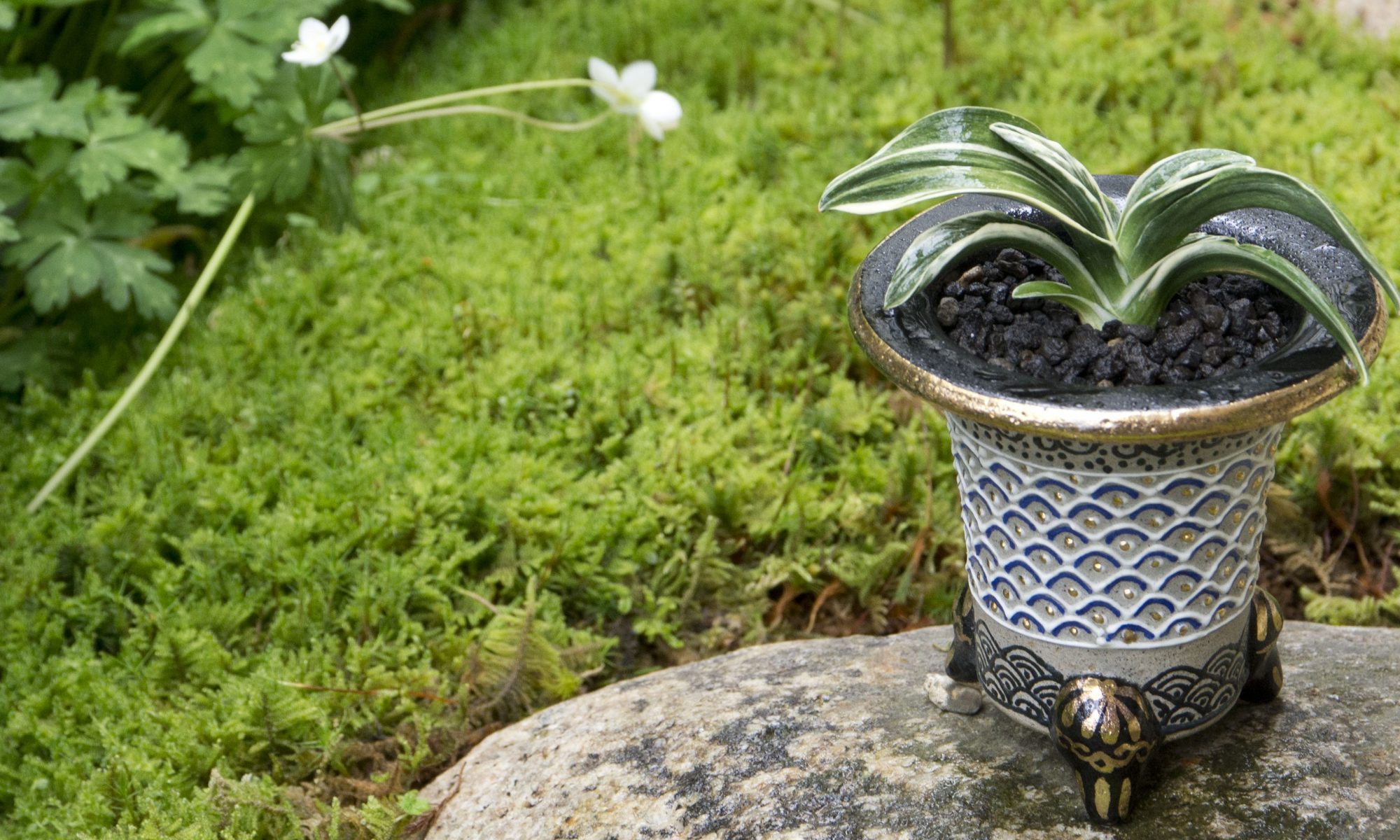日本のビザールプランツ 万年青
日本のビザールプランツ 万年青
1,ビザールプランツとは
2,日本のビザールプランツ
3,江戸時代からのビザールプランツ 万年青
4,1000種以上ある万年青の中から3つ紹介
・獅子 羅紗 裏芸
5,日本人の(変態的)感性
索引
ビザールプランツとは Bizarre Plants
ビザールプランツは、日本語で珍奇植物とも訳され、「珍奇な植物」や「奇妙な植物」という意味です。現代では、主に多肉植物や食虫植物、エアプランツなど、とにかく変わった形やめずらしい形の植物のことを呼びます。
どの時代でも、人と違うもの、普通のものでは満足できない、自分しかもっていないものが欲しい、という人がいます。
植物の世界も同じで、古くはヨーロッパ、中国、アラブの世界など、高貴な人々、お金を持った人びとは、だれも持っていない自分だけのビザールプランツを求めました。日本でも様々な珍しい植物が見出されました。
日本のビザールプランツ
1000年前の平安時代、源氏物語にも100種以上の植物が登場し、日本も古くから世界レベルの植物マニアでした。
ビザールプランツといえる、変わった植物を愛でる文化は、園芸文化が高貴な人だけでなく広く庶民にも花開いてゆく江戸時代にはじまります。
江戸時代からのビザールプランツ 万年青
当時誰も持っていないビザールプランツ、珍奇植物は非常に高価で、高貴な人、お金持ちに求められ、万年青では一鉢1億という金額の万年青もありました。江戸幕府は高価な万年青を禁止する贅沢禁止令を出すほどの熱狂ぶりを迎えます。
これは江戸時代に出版された本ですが、様々な変り万年青が掲載されています。万年青も独特、鉢にもこだわった様子が伝わってきます。
1000種以上ある万年青の中から3つ紹介
江戸から続く万年青の中から、3種類の珍奇植物をご紹介します。これは全部万年青の原種から日本人が作り上げてきたものです。
くるくるパーマの獅子
大元は江戸時代からあり、玉獅子といいます。くるくると葉が巻く姿が可愛いです。これは盆栽のように針金をかけたりせず、水が足りないわけでもなく、もちろん病気でもありません。自然と葉が巻いてきます。
現代は高度な交配技術により様々な獅子が生まれています。海外の人には一番人気でしょうか。
葉の変化の極致の羅紗
元の大きさから10分の1ほどに小型になり、葉の変化の極致の羅紗。1年生から親になっていく10年間、同じ品種とは思えないくらい目まぐるしく変化をしていくのも魅力です。
江戸時代もありましたが、現代はもっとすすんで5センチほどの1枚の葉に宇宙を見ることができます。
葉の裏側が変化する裏芸
こちらも江戸時代からの珍奇な植物です。葉が筒のようになったり、二枚重なったようになったり、ガリガリの葉になったり、玉、こぶが出てきたり。どれも病気ではなく自然です。
おわりに 日本人の植物に対するいい意味での変態的感性
他の人がもっていない、自分だけのビザールプランツ、見つかりましたか?世界の変った植物は、特殊な環境に適応して変わった植物になっていきましたが、万年青は、全部大元はただの青い万年青からです。ただの青い万年青から、日本人の美意識や、植物に対するいい意味での変態性でここまでの進化を遂げています。
世界のビザールプランツに負けない、フォルム、その花、殖え方、変化、寿命、まだまだ謎に包まれた万年青。これから10年は先に世界で有名になっていくかもしれませんね。
●動画解説 日本のビザールプランツ 万年青 【Bizarre Plants 珍奇植物】日本人の変態的感性 獅子 羅紗 裏芸 江戸時代からの珍奇趣味
【万年青の豊明園】【Rohdea japonica OMOTO】
珍奇植物・ビザールプランツ(Bizarre Plants)
・ビザープランツ(Bizarre Plants)
ビザーと発音するそうです。
What is Bizarre Plants? English ver.
Bizarre plants are also translated as rare plants in Japanese, meaning “rare plants” or “strange plants”. In modern times, we mainly refer to plants with unusual or unusual shapes, such as succulents, carnivorous plants, and airplants.
At any given time, there are people who want something that is different from others, that they cannot be satisfied with ordinary things, and that they have only themselves.
The world of plants is the same, and in the olden days, noble people and people with money, such as Europe, China, and the Arab world, sought their own bizarre plants that no one had. Various rare plants were also found in Japan.
Japanese Bizarre Plants
In the Heian period 1000 years ago, more than 100 species of plants appeared in the Genji Monogatari, and Japan has long been a world-class plant enthusiast.
The culture of adoring unusual plants, which can be called Bizarre Plants, began in the Edo period, when horticultural culture flourished not only to noble people but also to the general public.
Bizarre Plants from the Edo period OMOTO
Bizarre plants and rare plants that no one had at that time were very expensive, and were sought after by noble people and rich people. The Edo Shogunate is so enthusiastic that it issues a luxury ban that bans expensive OMOTO.
This is a book published in the Edo period, but it contains various strange OMOTO. OMOTO is also unique, and you can see how it was particular about the pot.
Introducing 3 out of more than 1000 kinds of OMOTO
Introducing three kinds of rare plants from the OMOTO that continues from Edo. This is all made by the Japanese from the original species of Rohdea japonica.
Round and round perm lion
Omoto has been around since the Edo period and is called the Tamashishi. The appearance of the leaves rolling around is cute. It doesn’t wire like bonsai, it doesn’t run out of water, and of course it’s not sick. The leaves roll up naturally.
In modern times, various lions are born by advanced mating technology. Is it the most popular with foreigners?
Rasha, the ultimate in leaf change
It is about one-tenth the size of its original size, and is the ultimate in changing leaves. It is also attractive that during the 10 years from the first grade to becoming a parent, the changes are so rapid that it is hard to believe that they are the same variety.
There was the Edo period, but nowadays you can see the universe on a leaf of about 5 cm.
The trick that the back side of the leaf changes
This is also a rare plant from the Edo period. The leaves become like cylinders, the leaves become double-layered, the leaves become crunchy, and balls and humps come out. All are natural, not ill.
Conclusion: A metamorphic sensibility in a good sense for Japanese plants
Did you find your own Bizarre Plants that no one else has? The strange plants in the world have adapted to the special environment and have become strange plants, but OMOTO is all from just original OMOTO. It has evolved from just original OMOTO to this point with Japanese aesthetics and metamorphosis in a good sense for plants.
The form, its flowers, how it grows, its changes, its longevity, and the mysterious OMOTO that is comparable to the world’s Bizarre Plants. The next 10 years may become famous in the world in the future.
